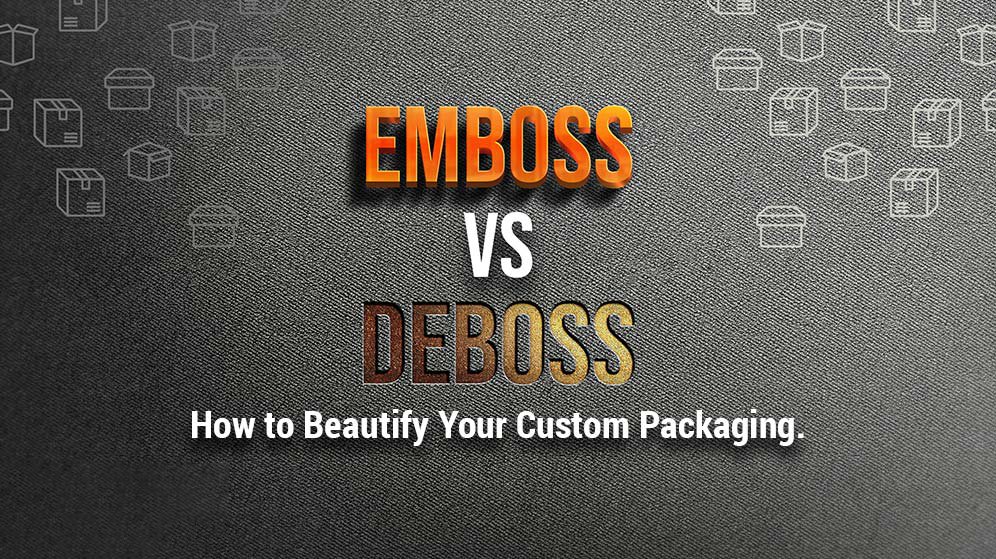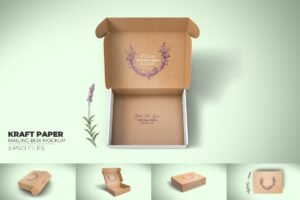Embossing and debossing is a popular finishing process that features images, artwork, designs, and texts into the paper and other materials to create raised outlines of your artwork design.
For instance, napkins and wristbands are clear examples of embossing and debossing. When it comes to Custom Packaging Boxes, choosing between embossing and debossing depends on several factors.
By giving your brand storylines and vibrant graphics a new depth, this type of designing technique creates visual complexity.

1. What Is Embossed Printing?
Embossed printing is a technique that adds a three-dimensional, raised texture to a printed surface. It involves creating a design or pattern that protrudes above the surrounding area, giving it a tactile and visually appealing effect. This process typically uses a combination of pressure and heat to shape the material, such as paper or cardstock.
The embossing can be either blind embossing, where only the raised texture is visible, or combined with foil stamping or color application to enhance the visual impact. For example, a logo embossed in gold foil on a black background can create a luxurious and sophisticated look.
2. Beneficial Aspects of Embossing
One of the significant benefits of embossing is its ability to create a sense of depth and texture. This tactile quality not only catches the eye but also engages the sense of touch, making the printed piece more memorable and impactful. It adds a premium and exclusive feel to the product or document, increasing its perceived value.
Embossing is also highly effective in enhancing brand recognition. A distinctively embossed logo or design can stand out on a crowded shelf or among a stack of papers, making the brand more recognizable and memorable. Moreover, it provides a level of security and authenticity, as it is more difficult to counterfeit or replicate an embossed design compared to a flat print.
In addition, embossing is a durable and long-lasting printing method. The raised elements are less prone to wear and tear, ensuring that the design remains intact over time. This makes it suitable for items that need to withstand frequent handling, such as book covers or packaging.
3. What Is Debossed Printing?
Debossed printing, on the contrary, creates a recessed or indented effect on the surface. The design or text is pushed inward, creating a subtle and elegant look. Similar to embossing, debossing can be done alone or in combination with other printing techniques to achieve different aesthetic results.
For instance, a debossed pattern on a leather-like material can give the impression of fine craftsmanship and quality. It offers a more understated and sophisticated alternative to embossing, appealing to those who prefer a subtler form of decoration.
4. Beneficial Aspects of Debossing
Debossing provides a refined and elegant touch to the printed material. It gives a sense of sophistication and restraint, making it suitable for products or designs that aim for a minimalist or classic aesthetic. It can also add a layer of intrigue, as the recessed elements catch light differently, creating a play of shadows and enhancing the visual depth.
Like embossing, debossing helps in brand differentiation. A unique debossed logo or design can set a brand apart from competitors and convey a sense of attention to detail and quality. It is often used in high-end products or exclusive editions to create a sense of exclusivity and desirability.
Furthermore, debossing can be used to create a functional aspect. For example, in a notebook or journal, debossed lines or grids can provide a subtle guide for writing without being overly obtrusive.
5. Importance of Embossing and Debossing
Embossing and debossing play a crucial role in the world of printing for several reasons. Firstly, they add a tactile element to the printed piece, making it more engaging and interactive. In a digital age where most communication is flat and two-dimensional, the physicality of embossed or debossed printing can make a powerful impression.
These techniques also contribute to the overall aesthetics and visual hierarchy of a design. They can be used to draw attention to key elements such as a logo, title, or important information, making the communication more effective.
Moreover, embossing and debossing are often associated with quality and craftsmanship. They indicate that extra effort and attention have been put into the production of the printed item, enhancing the brand’s image and reputation.
In marketing and packaging, these methods can significantly influence consumer perception and purchasing decisions. A product with an embossed or debossed label or packaging is more likely to be perceived as premium and worth the investment.
6. Embossing or Debossing? Which Should You Select?
The choice between embossing and debossing depends on various factors. Your brand personality and message are essential considerations. If your brand aims for boldness, opulence, and a sense of prominence, embossing might be the better option.
On the other hand, if your brand values understated elegance, refinement, and a more subdued presence, debossing could be the preferred choice.
The nature of the product or document also plays a role. For example, for a wedding invitation or a luxury perfume box, embossing might be more suitable to create a glamorous and celebratory feel. Whereas, for a fine stationery set or a minimalist product packaging, debossing could align better with the overall aesthetic.
Embossing can sometimes be more costly due to the complexity of the process and the materials required. If budget is a constraint, debossing might offer a more cost-effective yet still impactful alternative.
Ultimately, the decision should be based on a careful assessment of your design goals, brand image, target audience, and available resources. Both embossing and debossing have their unique charm and can elevate your printing project to new heights when used appropriately.
Conclusion
Embossing and debossing are powerful printing techniques that offer endless possibilities for creating visually stunning and memorable printed materials. Whether you choose to go for the raised allure of embossing or the recessed elegance of debossing, these methods have the potential to make your print stand out in a crowded marketplace and leave a lasting impression on your audience.
On our website, you may read client testimonials. Send an email to cady2016@foxmail.com at any time to receive professional assistance at a reasonable cost. You can reach us by phone at +86 15099817100.





